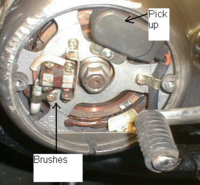Pattymatts
XS650 Member
Howdy guys!
First off id like to say thank you to anyone that posts on here and that can give me some insight. Okay so here's the lead up to this gripe. My bike was delivered from a cross-country freight last week, I was trying to kick her over because she'd been sitting for a bit and nothing, but every time I'd cut the ignition off I would here a sort of "poof", now I thought it was odd but kept going at it and eventually Lucy fired up. But it seemed the right cylinder wasn't doing too hot at all and after about 30 seconds she croaked. So you know, men take the path of least resistance, just like electricity, right!? I thought maybe she needed some new plugs. Replaced the plugs, and again, nothing. Took the plugs out one by one, grounded them on the case and gave her a few kicks, but the plugs just weren't lighting up. But here's the kicker, when I flipped my ignition OFF (single throw switch, no key), the plugs lit up(just once). Now a lightbulb went off and my dumbass brain said, "Ohhhh those 'poofs' were mini backfires!" Now I'm an aviation electrician with a few years experience, but I can't wrap my head around this gripe. Probably because it's a motorcycle and not a jet haha. But my electrician brain is calling out the coils or the switch. Please help, and thank you!
First off id like to say thank you to anyone that posts on here and that can give me some insight. Okay so here's the lead up to this gripe. My bike was delivered from a cross-country freight last week, I was trying to kick her over because she'd been sitting for a bit and nothing, but every time I'd cut the ignition off I would here a sort of "poof", now I thought it was odd but kept going at it and eventually Lucy fired up. But it seemed the right cylinder wasn't doing too hot at all and after about 30 seconds she croaked. So you know, men take the path of least resistance, just like electricity, right!? I thought maybe she needed some new plugs. Replaced the plugs, and again, nothing. Took the plugs out one by one, grounded them on the case and gave her a few kicks, but the plugs just weren't lighting up. But here's the kicker, when I flipped my ignition OFF (single throw switch, no key), the plugs lit up(just once). Now a lightbulb went off and my dumbass brain said, "Ohhhh those 'poofs' were mini backfires!" Now I'm an aviation electrician with a few years experience, but I can't wrap my head around this gripe. Probably because it's a motorcycle and not a jet haha. But my electrician brain is calling out the coils or the switch. Please help, and thank you!


